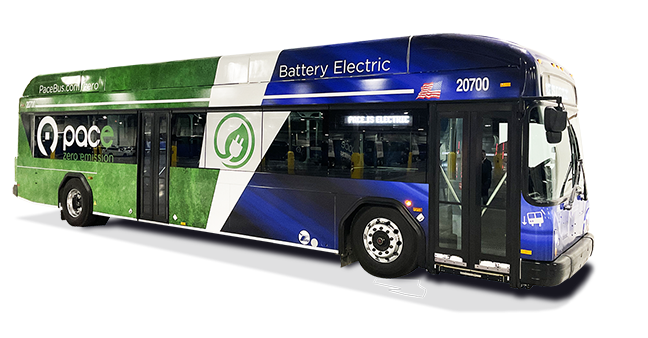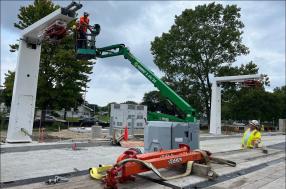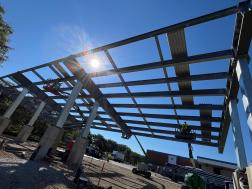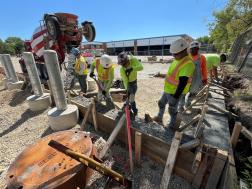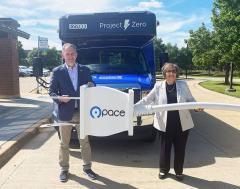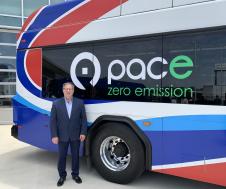Project Zero
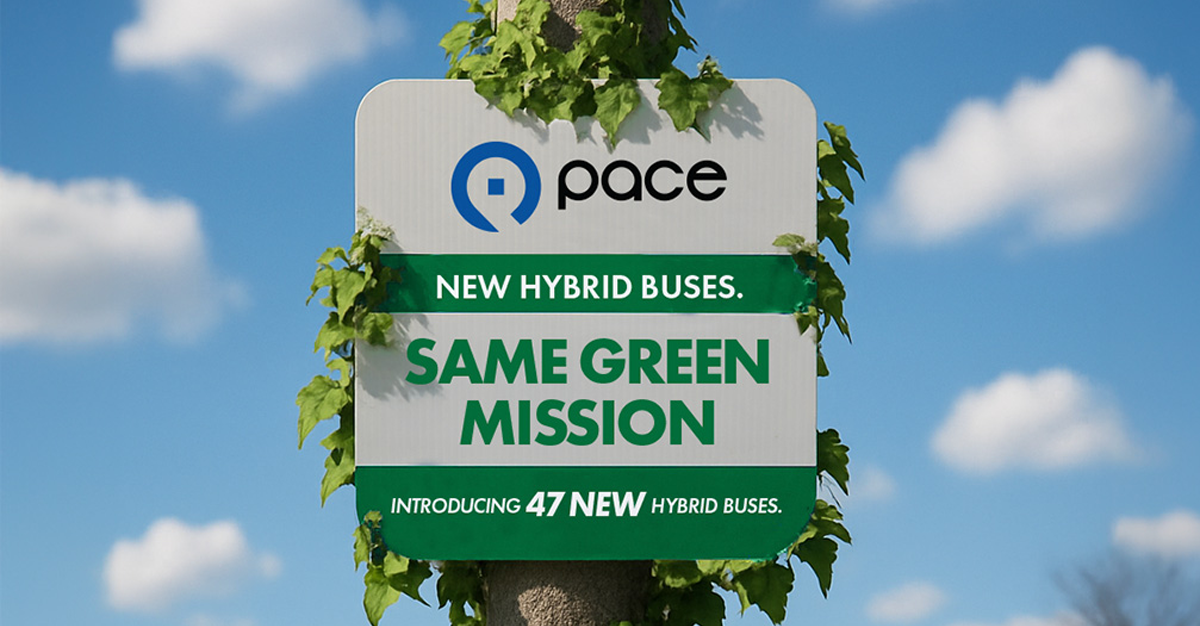
Pace is committed to the goal of operating 100% zero-emissions vehicles by the year 2040.
First and foremost, when commuters ride public transit instead of driving their own cars, air quality improves.
However, Pace also recognizes our responsibility for pollution reduction as an operator of hundreds of vehicles in our region. This is why one of Pace's top priorities is to reduce our carbon footprint and improve the quality of our community's environment. This effort to convert the entire Pace fleet to zero-emission vehicles is called Project Zero. Electric buses will be deployed based on the results of a fleet transition plan completed in December 2022. Pace zero-emission facilities study was finalized in March 2024.
As part of Driving Innovation, Pace committed in 2021 to converting Pace's entire bus fleet to zero-emission vehicles by 2040.
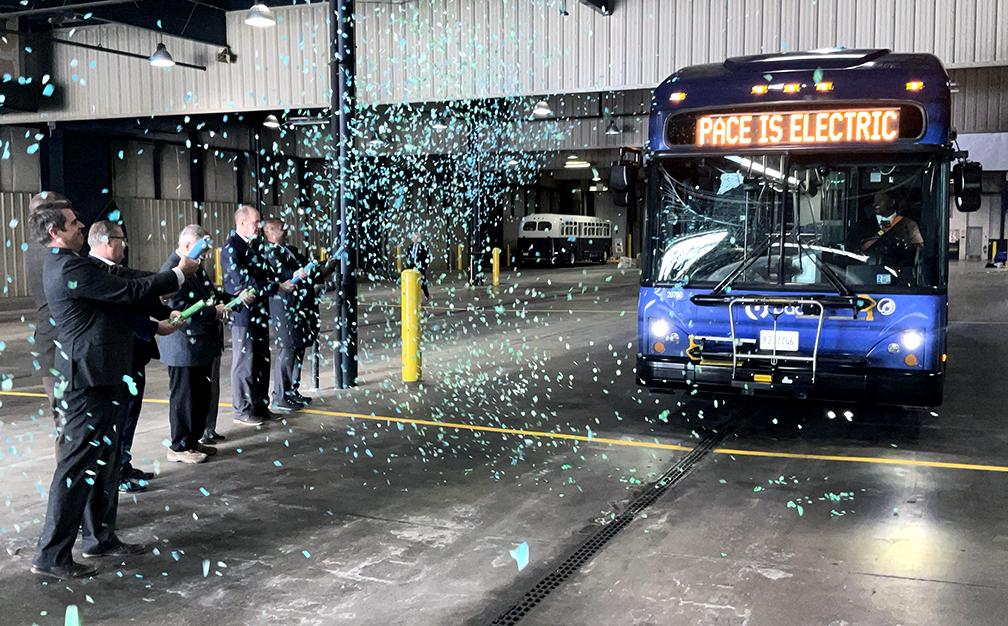
Making Progress
- On November 20, 2025, FTA awarded Pace a $39.78 million Low or No Emissions grant for hybrid buses.
- On January 19, 2024, Pace’s inaugural electric bus entered service on Route 381 along 95th Street, serving riders in the southwest suburbs.
- Pace anticipates the delivery of 47 hybrid-electric buses in late 2025, and another 33 in 2026.
- Pace ordered an additional 22 electric fixed route buses, which are expected to be delivered in 2026. Funding for another batch of 27 electric fixed route buses has also been secured, thanks to an Illinois EPA grant.
- Pace's North Division in Waukegan is scheduled to become a zero-emission-only facility by 2027.
- Pace has received its first battery-powered paratransit vehicle, which is currently in pre-launch testing. Another four electric paratransit vehicles are on order, thanks to Community Project Funding sponsored by Congressmen Casten and Foster.
- Funding for an electric coach bus for I-55 express service is secured, thanks to Community Project Funding sponsored by Congresswoman Underwood.
Beyond those Project Zero highlights noted above, Pace has also taken the following environmentally-friendly steps:
- Design and construction costs are fully funded to outfit the River Division facility to operate an initial fleet of 20 battery electric buses, up to 35 electric paratransit vehicles, and additional battery electric buses in the future.
- Pace follows federal guidelines related to clean diesel and maintaining different engine types to maximize productivity and minimize pollution. We use ultra-low sulfur fuels that meet all federal requirements.
- Pace provides its employees with a $75 monthly incentive to commute to work in a vanpool. Learn how you can join a carpool or vanpool at PaceCommuterRideshare.com
- Pace recycles tires that can be used for playground flooring, tire retreading, and even tire-derived fuel.
- Pace uses transit signal priority on several corridors, which saves fuel and reduces carbon emissions released into the air by buses idling at a red light
- Any newly purchased diesel-fueled bus has transmissions and hydraulic systems, which use synthetic fluids that extend drain intervals (every 75,000 miles instead of 12,000) for reduced environmental impact.
- A new Northwest Division facility in Wheeling is being constructed for future zero-emission capabilities.
Due to the expense of making this zero-emissions transition, funding is a critical element of achieving the goals of Project Zero. Much of the funding needed for vehicles and facilities is not yet identified, but Pace is actively pursuing sources of funding to further progress on this project.
- Pace and the Illinois Environmental Protection Agency entered into a grant agreement in January 2025 for the purchase of 27 electric buses.
- Vehicles are being obtained through various funding sources including Pace's 2022-26 capital budgets, operating funds, federal and state grants, pursing potential congressional community project funding, and Volkswagen settlement funding.
- The Regional Transportation Authority (RTA), in partnership with Pace, also recently applied for U.S. EPA Climate pollution reduction act funding that would allow Pace to purchase additional EV vehicles.
- Pace is using funding from the Rebuild Illinois capital program and the federal government for facility improvements at North Division. The funding will help realize our goal of housing a fully electric fleet at North Division by 2027 and ensure the project is fully funded.
In total, meeting our Project Zero commitment could cost approximately $2.5 billion--$1 billion for vehicles and $1.5 billion to update Pace’s ten bus garages.
Driving Innovation
An integral part of Pace's Driving Innovation plan is the "Electric Bus; Zero-Emission Fleet Transition" initiative. Driving Innovation includes 4 pollution reduction action items:
ACTION ITEM 1 - Implement 100 Percent Zero-Emission Fleet by 2040
Chapter 1 of Driving Innovation discusses the profound environmental impact of greenhouse gas emissions on the climate crisis. While Pace by its very nature as a transit agency helps reduce regional transportation-related emissions in taking cars off the road and instead riding Pace’s family of services, our agency is nonetheless still an emitter of greenhouse gases using diesel-powered vehicles.
Whether through battery electric buses (BEB) or other alternative transit fleets, Pace will remain adaptable in its approach to fulfilling its goal of environmental stewardship, while concurrently ensuring fiscal solvency and making the most use of taxpayer dollars.
Update: in December 2022, the Pace Board approved the Zero Emission Bus Transition Plan.
ACTION ITEM 2 - Implement Battery Electric Bus (BEB) Technology
Pace recognizes how interest in electrifying vehicles across private industry and US federal, state, and local governments has intensified in recent years. Electric buses are being added to the fixed route and paratransit fleets. Looking ahead, the agency will holistically evaluate a transition path to converting its fleet to battery electric buses (BEB).
Among the many first steps we are taking, Action Item 2 of the A-2 Capital Improvement Projects initiative describes Pace’s Facilities Plan, approved in March 2024.
ACTION ITEM 3 - Diesel & Compressed Natural Gas (CNG) Transition
Pace has begun to implement steps toward converting the agency’s entire bus fleet to zero-emission vehicles by 2040.
Pace's first electric fixed route bus went into service in January 2024 at Southwest Division in Bridgeview. Pace has begun electrification of the North Division facility in Waukegan and is under construction with Phase 1 improvements, which will accommodate 12 BEBs. Pace plans to complete the necessary facility renovations and have 60 BEBs implemented at North Division in 2027.
The conversion of over 700 fixed route buses to ZEBs is a complex effort that requires new vehicles and equipment, as well as upgraded facility infrastructure.
ACTION ITEM 4 - Investigate Emerging Alternative Fleets
Pace recognizes that other vehicle propulsion technologies may have potential to one day replace or augment Pace’s transit fleet beyond its forthcoming BEB technology.
Transit agencies across the nation have been investigating, piloting and operating alternatives such as hydrogen fuel cell electric buses (FCEBs). There may also be long-term cost efficiencies in retooling CNG facilities with fuel cell technologies that are worth further investigation. Moreover, completely new and innovative technologies may be invented and developed in the coming years which may be of interest for Pace to explore.
Overall, Pace will carefully weigh the implications of operating multiple vehicle technologies under any scenario and ensure its ability to maintain the highest standards in safety, training, and maintenance prior to making new commitments. Additionally, Pace will ensure that previous funding for technologies such as CNG, BEB, or any other new technology is not wasted and that assets reach the full useful life cycle before being replaced or are otherwise repurposed to achieve the highest possible return on investment.
How Can I Help?
